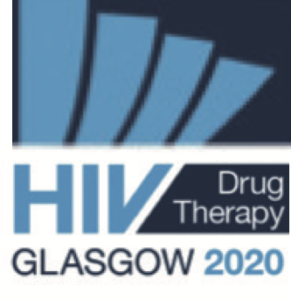Capsid inhibitor lenacapavir, dosed six-monthly, has high barrier to drug resistance and no cross-resistance to other classes
14 October 2020. Related: Conference reports, Antiretrovirals, HIV 15 Glasgow 2020.
 Simon Collins, HIV i-Base
Simon Collins, HIV i-BaseNew data at the Glasgow conference on the capsid inhibitor lenacapavir included results on drug resistance. Although two participants in a proof-of-concept phase 1b dose finding study on each of the lowest doses developed a single resistance mutation, this will be overcome at the higher doses used for phase 2/3 development. [1]
Lenacapavir (previously GS-6207) is a first-in-class capsid inhibitor active at several stages of the viral lifecycle. It has high potency (30 – 100 pM) and as a new class, is sensitive to HIV that is drug resistant to other classes including maturation inhibitors. A single subcutaneous injection is expected to provide treatment coverage for six months.
This study randomised 39 treatment-naïve participants to a single dose of 20, 50, 150, 450 and 750 mg (n=6, 6, 6, 6 and 5) or placebo (n=10) as monotherapy. ART was started at day 10 (bictegravir/FTC/TAF) and follow-up continues to day 225.
Mean viral load responses at day 10, reported earlier this year at CROI, were dose-related and ranged from –1.3 log to –2.3 log in the 20 mg and 750 mg doses, respectively. [2]
In vitro passaging studies have previously identified seven mutations associated with reduced sensitivity to lenacapavir: at positions L56I, M66I, Q67H, K70N, N74D, N74S and T107N in HIV-1 capsid.
However, previous resistance studies found no pre-existing mutations in samples from 1500 treatment naïve samples and 51 experienced samples retained wild-type sensitivity.
In this study, all participants had wild-type susceptibility to lenacapavir at baseline with no detection of capsid mutations.
However, at day 10, two participants showed Q67H at lowest doses – one each in the 20 mg and 50 mg groups, at day 10 and day 7 respectively. From the group listed above, this mutation has the lowest impact on reduced sensitivity (approximately 6-fold).
No other substitutions were seen in capsid using next generation sequencing Seq-IT test.
The 20 mg case showed Q67Q/H mix at day 10, and VL reduction continued after adding BIC/F/TAF.
The 50 mg case showed Q67H at day 7, detected only by the more sensitive next generation sequencing, but with evidence of a viral rebound in the few days before ART at day 10.
Both participants achieved undetectable viral load on ART.
However, the presentation showed that drug resistance would be unlikely at higher doses. Maximal viral load reductions in dose response curves occurred between the 50 and 150 mg doses and this corresponded to mean lenacapavir concentrations at >4.4 ng/mL (IQ>1.1).
This is much lower than the predicted concentrations with the 300 mg and 600 mg doses selected for the phase 2/3 clinical programme which should range from 24 ng/mL (minimum) to 67 ng/mL (maximum), indicating an IQ >8 at six months and a very low probability of drug resistance.
comment
These data continue to be encouraging and are optimistic for future long-acting combinations.
In the Q&A afterwards, there was no reference to which other long-acting drugs would be used with lenacapavir. However, Gilead recently bought the rights to two long-acting bNAbs from Rockefeller University, both of which might also allow 6-monthly dosing.
Technically, and perhaps as lower cost molecules, either a monthly islatravir oral pill or an annual islatravir implant would both be very acceptable options for people taking treatment.
References
- Margot N et al. Lenacapavir resistance analysis in a phase 1b clinical proof-of-concept study. Glasgow. Oral presentation. Poster O-324. JIAS 2020, 23(S7):e25616.
URL not yet available. - Daar E et al. Dose-response relationship of subcutaneous long-acting HIV capsid inhibitor GS-6207. CROI 2020, 8-11 March, 2020. Abstract 469.
https://www.croiconference.org/abstract/dose-response-relationship-of-subcutaneous-long-acting-hiv-capsid-inhibitor-gs-6207 (abstract)
http://www.croiwebcasts.org/console/player/44860 (webcast)
This report was first published online on 8 October 2020.

